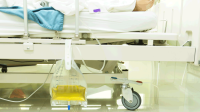We are hearing much talk about the unseasonably warm weather in some areas and extreme conditions in others. Frequently, we hear something about the role of global warming. In any event, the health of the environment impacts all of us. The role of nurses in controlling the influence of environmental factors (air and water quality, food, sanitation, cleanliness, chemicals, pesticides, waste products) on health was recognized in the early years of the nursing profession by such leaders as Florence Nightingale and Lillian Wald. Florence Nightingale, in her Notes on Nursing, expressed as the first rule of nursing, “Keep the air within as pure as the air without.”
Mounting scientific evidence indicates that the human body is being overwhelmed with chemicals found in air, water, food, household products, healthcare settings, and even in the delivery of health care. It is very concerning that one study demonstrated the ability of chemicals to pass through the placental barrier to the developing fetus. The baby is born “pre-polluted,” with an average of 200 chemicals and pollutants found in the cord blood, some originating from lifelong exposure of the mother to chemicals.
Nurses have been leaders in advocating for and implementing environmental principles into their professional roles and practices, not only to help eliminate the problem, but to use precaution when science is not yet able to fully establish the cause and effect relationship. The Precautionary Principle, which ANA adopted in 2003, implies that there is an ethical imperative in preventing disease rather than just treating disease, thus transferring the burden of proof to those creating the risk. The principle advocates taking the life cycle of chemicals, products, or technologies into consideration and acting accordingly to prevent exposures. It is wise to be proactive rather than sit back and prepare to treat the disease resulting from environmental insult.
ANA has contributed to this tradition of environmental stewardship in many ways. In addressing the 1997 House of Delegates report “Reduction of Health Care Production of Toxic Pollution,” ANA agreed to support and lobby for dioxin emission standards for medical waste incinerators that are at least as rigorous as those for hazardous waste incinerators; to promote the use of alternatives to polyvinyl chloride (PVC) products; to commit to mercury-free healthcare facilities; and to promote the use of nonincineration methods of disposal for healthcare wastes while educating registered nurses and other healthcare personnel about medical waste issues.
In 1998, ANA, together with Health Care Without Harm, partnered with the American Hospital Association and the U.S. Environmental Protection Agency to establish the Hospitals for a Healthy Environment (H2E) program, aimed at reducing the volume and toxicity of waste generated by the healthcare field. H2E became an independent organization in 2006 with the continued leadership involvement of ANA.
ANA has demonstrated commitment to environmental health through action adopted by the House of Delegates in 2004 on “Inappropriate Use of Antimicrobials in Agriculture.” ANA then commissioned the development of the environmental health principles with support of public policy utilizing the Precautionary Principle and the 2006 action on “Nursing Practice, Chemical Exposures and Right-to-Know,” including safe cosmetics. To serve as a call to action, “Environmental Principles for Nursing Practice” has been developed by the ANA Congress on Nursing Practice and Economics for utilization by the entire nursing profession. At this writing, this position will go to the Board for approval in mid-March.
You can become involved in advocating for the environment in numerous ways. Find out what happens to medical waste at your facility and work to be sure there is a nonincineration technology in use. How is the solid waste being handled? Become informed about the issues and help nurses and others learn the link between environmental exposures and health. Seek opportunities to educate at your workplace, schools, and community about the dangers of mercury. Advocate for the use of PVC-free products in health care. Get involved in purchasing decisions in your workplace. Join with other nurses to have your voice heard. Tell your story on www.luminaryproject.org. There are many more ways to be active on this issue.
We, as nurses, can impact the health of the individual, the community, and the world. Join me as we carry on the tradition of those who came before us. Let’s work together to ease the suffering by preventing environmental disease as we address environmental health issues.
Rebecca M. Patton, MSN, RN, CNOR
President
American Nurses Association


















